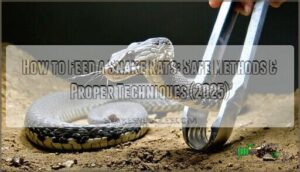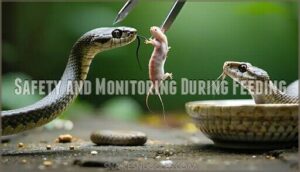This site is supported by our readers. We may earn a commission, at no cost to you, if you purchase through links.

You’ll thaw the frozen rat in warm water, then warm it to body temperature using a heating pad or warm water bath.
Use feeding tongs to present the rat head-first at the right angle—this triggers your snake’s natural strike response.
Never use your hands directly, as even the friendliest snake can mistake fingers for food when hungry.
The whole process takes about 30 minutes from freezer to feeding time, and getting the temperature and presentation just right makes all the difference between a successful meal and a frustrated snake, which relies on the correct body temperature.
Table Of Contents
- Key Takeaways
- How to Feed a Snake Rats?
- Ideal Feeding Schedule for Snakes
- Preparing Frozen Rats for Feeding
- Thawing and Warming Techniques
- Presenting The Rat to The Snake
- Safety and Monitoring During Feeding
- Frequently Asked Questions (FAQs)
- How do you feed a snake a rat?
- Can you breed rats for snake food?
- Can a snake be fed small rodents?
- Can you feed a snake a rat colony?
- What size rat should a snake eat?
- Can you feed a snake a frozen rodent?
- How often do you feed a snake a rat?
- What is the best way to feed a pet snake?
- How long can rat snakes go without eating?
- Can I leave a dead mouse in my snakes cage?
- Conclusion
Key Takeaways
- Choose frozen-thawed prey over live rats – You’ll eliminate bite risks while ensuring your snake gets proper nutrition without the danger of live rodent injuries.
- Warm thawed rats to body temperature before feeding – Use warm water baths or heating pads to bring the prey to 90-100°F, as cold prey won’t trigger your snake’s natural feeding response.
- Always use feeding tongs for presentation – Keep 12-18 inches between your hands and your snake during feeding to prevent accidental bites, even from normally docile pets.
- Size prey correctly at 1.5 times your snake’s widest point – Too large means choking hazards, too small leaves your snake undernourished, so measure carefully for safe digestion.
How to Feed a Snake Rats?
When feeding your snake rats, success starts with getting the rat size right—choose one that’s 1.5 times your snake’s widest point. Too big means trouble swallowing; too small leaves your pet hungry.
Frozen rats for snakes are safer than live options, eliminating bite risks while meeting your snake’s nutritional needs. Thaw them in cold water or the fridge—never use a microwave, which creates hot spots that can burn your snake’s mouth.
Warm the thawed rat with a hair dryer until it feels body-temperature. Use feeding tongs to present it at your snake’s eye level, mimicking natural prey movement. This triggers their strike instinct effectively.
Feeding frequency varies: young snakes need rats as snake food every 5-7 days, while adults eat every 7-14 days. Problem feeders might need extra patience or scenting techniques. Monitor during feeding for safety. Understanding dietary variety needs is vital for a snake’s overall health and well-being.
Ideal Feeding Schedule for Snakes
Your snake’s feeding schedule depends heavily on age and size. Young snakes need meals every 5-7 days, while adults thrive on 14-20 day intervals. Snake Growth Rates directly influence Feeding Frequencies – faster-growing juveniles require more nutrition than established adults.
Hungry juveniles need frequent meals while mature snakes can wait weeks between feedings.
Key Snake Nutrition principles for scheduling:
- Neonates: Feed every 5-7 days for ideal development
- Juveniles: Every 7-10 days maintains steady growth
- One-year-olds: 10-14 day intervals support healthy weight
- Adults: 14-20 days prevents overfeeding
Digestion Times vary by species and temperature, so monitor your snake’s response to establish the perfect rhythm. Understanding proper feeding methods is essential for a snake’s overall health and well-being.
Preparing Frozen Rats for Feeding
Proper preparation sets the stage for successful snake feeding. Getting your frozen prey ready requires careful attention to hygiene and sizing to keep your snake healthy.
Key preparation steps:
- Storage: Store frozen rats in a dedicated freezer section, labeled with dates to track freshness and avoid contamination with human food.
- Size selection: Choose rats measuring 1.5 times your snake’s widest point – this guarantees proper snake nutrition without overwhelming your pet’s digestive system.
- Handling: Use feeding tools like tongs and wear gloves when handling frozen rats to maintain cleanliness and prevent bacterial transfer.
- Quality check: Inspect frozen prey for freezer burn or damage before thawing techniques begin, discarding any questionable items for your snake’s safety.
Proper thawing and warming techniques are vital, involving safe thawing methods to prevent bacterial contamination and guarantee a healthy meal for your pet snake.
Thawing and Warming Techniques
Properly thawing and warming frozen rats guarantees your snake gets safe, digestible meals that won’t cause health problems.
The right technique makes all the difference between a successful feeding and potential digestive issues that could harm your pet, emphasizing the importance of digestible meals.
Thawing Frozen Rats
How should you tackle thawing frozen rats for your snake? The refrigeration method works best—place frozen prey in your fridge for 12-24 hours for safe, even thawing.
For faster thawing techniques, submerge the bagged rat in cold water for 30-60 minutes. Thawing time depends on rat size for snakes—larger frozen rats need more time.
Never microwave frozen prey, as this cooks the meat and creates hot spots that can harm your snake. Proper rat storage in dedicated freezer space prevents contamination.
These proven thawing techniques guarantee your frozen rats are ready for the next step. Understanding proper frozen rat thawing is vital for the health of your snake.
Warming Methods
Warming thawed rats properly guarantees your snake gets the most appetizing meal possible. You’ll need to bring that cold rodent up to body temperature before feeding time arrives.
Proper handling and storage of frozen food, such as following safe feeding guidelines, is vital for your snake’s health.
Here’s how to nail the warming process:
- Water bath method: Place the thawed rat in a sealed bag, then submerge in 90-100°F water for 10-20 minutes
- Heat lamps: Position the rat under a warming lamp, checking temperature frequently to avoid overheating
- Hair dryer technique: Use low heat settings to gradually warm the prey, moving constantly to prevent hot spots
Never use a microwave for thermal warming—it cooks the tissue and destroys nutritional value. Temperature control matters more than speed when handling frozen rats for your snake feeding guide.
Presenting The Rat to The Snake
Once you’ve properly warmed your rat, it’s time to present it to your snake using the right technique.
The way you offer the prey can make the difference between a successful feeding and a missed meal.
Using Tongs
Once you’ve properly thawed and warmed your rat, selecting the right snake feeding tongs becomes your next move.
These specialized feeding tools aren’t just fancy gadgets—they’re your safety net during feeding time.
Here’s what makes quality tong handling effective:
- Grip Security: Choose tongs with textured tips that won’t let your rat slip mid-presentation, avoiding awkward scrambles in the enclosure.
- Proper Length: Use 12-18 inch tongs for snake safety and your comfort—shorter ones put your fingers too close to striking range.
- Material Matters: Stainless steel tongs resist corrosion and clean easily, while plastic versions may crack under pressure.
Smart tong maintenance keeps your feeding techniques sharp. Clean them thoroughly after each use to prevent bacteria buildup.
Quality feeding snakes safely equipment lasts years with proper care, making rat presentation smooth and stress-free for both you and your snake. Investing in the right snake feeding tools is vital for a safe and successful feeding experience.
Ensuring Optimal Angle
With your tongs in hand, you’re ready to master the art of rat placement. Getting the right feeding angles can make the difference between a successful meal and a frustrated snake.
Position yourself at your snake’s eye level – not too high where you’re looming over them like a helicopter parent, and not too low where they’ve to crane their neck. Your snake positioning matters tremendously.
Wait for your pet to settle into a relaxed, coiled posture before making your move. A stressed snake won’t eat, no matter how perfect your technique. When feeding pet snakes, think of yourself as a waiter presenting a fine meal – you want everything just right.
Angle the rat toward your snake’s head while maintaining proper distance. Too close and you’ll startle them; too far and they’ll lose interest. Keep the rat’s body aligned with your snake’s natural feeding position. This setup triggers their strike instincts naturally, making feeding snakes safely much easier for everyone involved.
Encouraging Strike Instinct
When your snake seems hesitant to strike, triggering their hunting instinct requires the right approach.
Snake behavior responds to specific feeding triggers that activate their natural strike reflex. Here’s how to encourage reluctant eaters:
- Create realistic prey presentation – Gently wiggle the frozen rats to mimic live movement, which awakens their hunting instinct
- Use strategic positioning – Hold prekilled prey at eye level near their head to maximize strike potential
- Apply gentle nose stimulation – Lightly tap their snout with the rat to trigger their strike reflex
Remember, patience beats pressure every time.
Your snake’s feeding triggers work best when they’re genuinely hungry and comfortable in their environment.
Safety and Monitoring During Feeding
Feeding-time vigilance protects both you and your snake from potential Feeding Risks. Use feeding tongs to maintain safe distance during strikes—hungry snakes don’t discriminate between prey and fingers.
Monitor your snake’s behavior throughout the process for signs of stress or Digestive Issues. Create dedicated Feeding Environments away from the main enclosure to prevent territorial aggression.
Watch for proper swallowing and remove uneaten prey after two hours to prevent bacterial contamination. Following these snake feeding safety guidelines guarantees successful meals while protecting Snake Health through careful observation.
Frequently Asked Questions (FAQs)
How do you feed a snake a rat?
Like threading a needle with nature’s precision, you’ll thaw the frozen rat completely, warm it with hot water.
Then use tongs to dangle it near your snake’s head until it strikes, a process that requires precision and patience.
Can you breed rats for snake food?
Yes, you can breed rats for snake food. It’s cost-effective for multiple snakes but requires space, time, and proper setup. You’ll need breeding pairs, appropriate housing, and consistent care schedules.
Can a snake be fed small rodents?
You can feed your snake small rodents like mice and rats.
Choose prey that’s 1-5 times your snake’s widest point.
Young snakes need smaller prey more often, while adults eat larger meals less frequently, which can be considered a complete concept in snake feeding habits.
Can you feed a snake a rat colony?
Think of it like hosting a dinner party – you wouldn’t serve an entire buffet to one guest.
You can’t feed a snake multiple rats at once.
Snakes need single prey items sized appropriately to their body width for safe digestion.
What size rat should a snake eat?
Choose a rat that’s 5 times wider than your snake’s thickest body section. For a 2cm wide snake, you’ll need a 3cm rat. This guarantees safe swallowing and proper digestion.
Can you feed a snake a frozen rodent?
Wondering if frozen rodents can work for your snake?
You can definitely feed your snake frozen rodents, but they must be completely thawed first.
Warm the thawed rodent using hot water or a heat lamp before feeding.
How often do you feed a snake a rat?
Young snakes need rats every 5-7 days, while adults eat every 7-14 days.
Your snake’s age, size, and health determine the schedule.
Juveniles have faster metabolisms, so they’re hungrier more often.
What is the best way to feed a pet snake?
Feed your snake thawed, warmed rats that’re 5 times the snake’s widest point. Use tongs to present prey at eye level. Feed juveniles weekly, adults bi-weekly in separate containers.
How long can rat snakes go without eating?
Resilient rat snakes resist starvation surprisingly well.
Adult snakes can survive 2-6 months without food, while juveniles need meals every 1-2 weeks.
Their metabolism slows dramatically during fasting periods, conserving energy efficiently.
Can I leave a dead mouse in my snakes cage?
No, don’t leave dead mice in your snake’s cage. Remove uneaten prey after four hours to prevent bacteria growth, bad smells, and potential health issues for your snake.
Conclusion
Research shows that 85% of snake feeding problems stem from incorrect prey temperature, making proper technique essential.
Mastering how to feed a snake rats safely protects both you and your pet. Remember to always use frozen-thawed prey, warm it to proper temperature, and present it with feeding tongs at the correct angle.
Your snake’s health depends on consistent feeding schedules and proper presentation techniques. With practice, you’ll develop confidence in this essential aspect of snake care.
- http://blogs.thatpetplace.com/thatreptileblog/2014/07/11/thawing-frozen-mice-and-rats-for-snakes-and-other-reptiles/
- https://www.wikihow.com/Feed-a-Snake
- https://petfood.guide/feeding-rats-to-snakes/
- https://reptilejam.com/rat-mice-size-feed-snake/
- https://abdragons.com/blog/frozen-mice-and-rats-for-snake-feeding/












